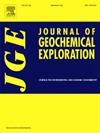利用磷灰石地球化学方法区分西田矿田(中国南方)三叠纪含W-Sn矿和不含矿的岩体
IF 3.4
2区 地球科学
Q1 GEOCHEMISTRY & GEOPHYSICS
引用次数: 0
摘要
虽然西田W-Sn矿床的成矿过程已经确定,但区分三叠纪W-Sn含矿花岗岩和无矿花岗岩的关键因素仍不确定,这为了解三叠纪W-Sn成矿的控制因素留下了重要空白。在本研究中,我们对三叠纪龙上含W-Sn矿花岗岩和古大兰无矿花岗岩中的磷灰石进行了全面调查,以追溯母岩的性质,并为西田矿田(华南)三叠纪W-Sn成矿作用的相关过程提供约束。含矿花岗岩(AOB)和无矿花岗岩(AOF)中的磷灰石呈现出不同的阴极发光(CL)图像:含矿花岗岩样品具有较暗的岩心和较亮的岩缘,岩缘部分具有同心振荡生长分带,而无矿花岗岩样品在阴极荧光图像中表现出混乱的纹理。在 Tera-Wasserburg 图上,AOB 和 AOF 的 U-Pb 年龄测定结果分别为 227.3 ± 4.3 Ma (1σ, MSWD = 3.9) 和 227.1 ± 7.8 Ma (1σ, MSWD = 2.4)。所研究的磷灰石具有相似的εNd(t)值(AOB为-10.91至-9.82;AOF为-10.42至-8.77)(以与CHUR成分的万分之一偏差表示)、相对较低的Cl含量(<0.05 wt%)和较高的F含量(~3 wt%),这表明含W-Sn矿石和无矿石的花岗岩岩浆都是由旧大陆地壳熔融产生的。AOB中的纹理和高浓度的REE + Y和Th可被认为是流体溶解的结果。混乱的质地、147Sm/144Nd比率的广泛变化,可能意味着AOF可能经历了元古代改造。青奥边界的 Eu/Eu* 值较低,Ce/Ce* 值较高,这表明含 W-Sn 矿花岗岩的环境更为贫化。较低的 Sr、Mg 含量和较高的 Y 含量表明,含 W-Sn 矿花岗岩的分馏程度高于无矿花岗岩。我们认为,热液对W和Sn的移动和运移能力对W和Sn的富集起着重要作用,岩浆的氧化还原状态和岩浆分异程度决定了钨和锡的最终富集水平。本文章由计算机程序翻译,如有差异,请以英文原文为准。
Differentiating Triassic W–Sn ore-bearing and ore-free plutons in the Xitian Ore Field (South China) using apatite geochemistry
Though the metallogenic process of the Xitian W–Sn deposit has been established, the key factors distinguishing Triassic W–Sn ore-bearing granites from ore-free granites remain uncertain, leaving an important gap in understanding the controls on Triassic W–Sn mineralization. In this study, we present a comprehensive investigation of apatite from the Triassic Longshang W–Sn ore-bearing and Goudalan ore-free granites, to trace the nature of parental magma and to provide constraints on the processes related to Triassic W–Sn mineralization in Xitian Ore Field (South China). Apatites from ore-bearing (AOB) granites and apatites from ore-free (AOF) granites exhibit distinct Cathodoluminescence (CL) images: AOB samples feature darker cores and brighter rims, with concentric oscillatory growth zoning in the rim sections, whereas AOF samples exhibit chaotic textures in CL images. The U–Pb age dating of AOB and AOF yield a lower intercept age of 227.3 ± 4.3 Ma (1σ, MSWD = 3.9) and 227.1 ± 7.8 Ma (1σ, MSWD = 2.4) on the Tera-Wasserburg diagrams, respectively. The similar εNd(t) values (−10.91 to −9.82 for AOB; −10.42 to −8.77 for AOF) (expressed as deviation in parts per 10,000 from CHUR composition), relatively low Cl contents (<0.05 wt%), and high F (~3 wt%) of studied apatites, suggest that W–Sn ore-bearing and ore-free granitic magmas were both generated by melting of old continental crust. The texture and high concentration of REE + Y and Th in AOB could be assumed as the result of fluid exsolution. The chaotic texture, broad variation in 147Sm/144Nd ratios, may imply that AOF might have experienced metasomatic modification. Lower Eu/Eu* value together with higher Ce/Ce* value in AOB suggests a more reduced environment for W–Sn ore-bearing granites. Lower Sr, Mg content, and higher Y contents suggest that W–Sn ore-bearing granites have a higher degree of fractionation than ore-free granites. We propose that the mobilization and transport ability of W and Sn by hydrothermal fluids play an important role in the enrichment of W and Sn, and redox state of magma and the degree of magma differentiation determine the final enrichment level of tungsten and tin.
求助全文
通过发布文献求助,成功后即可免费获取论文全文。
去求助
来源期刊

Journal of Geochemical Exploration
地学-地球化学与地球物理
CiteScore
7.40
自引率
7.70%
发文量
148
审稿时长
8.1 months
期刊介绍:
Journal of Geochemical Exploration is mostly dedicated to publication of original studies in exploration and environmental geochemistry and related topics.
Contributions considered of prevalent interest for the journal include researches based on the application of innovative methods to:
define the genesis and the evolution of mineral deposits including transfer of elements in large-scale mineralized areas.
analyze complex systems at the boundaries between bio-geochemistry, metal transport and mineral accumulation.
evaluate effects of historical mining activities on the surface environment.
trace pollutant sources and define their fate and transport models in the near-surface and surface environments involving solid, fluid and aerial matrices.
assess and quantify natural and technogenic radioactivity in the environment.
determine geochemical anomalies and set baseline reference values using compositional data analysis, multivariate statistics and geo-spatial analysis.
assess the impacts of anthropogenic contamination on ecosystems and human health at local and regional scale to prioritize and classify risks through deterministic and stochastic approaches.
Papers dedicated to the presentation of newly developed methods in analytical geochemistry to be applied in the field or in laboratory are also within the topics of interest for the journal.
 求助内容:
求助内容: 应助结果提醒方式:
应助结果提醒方式:


